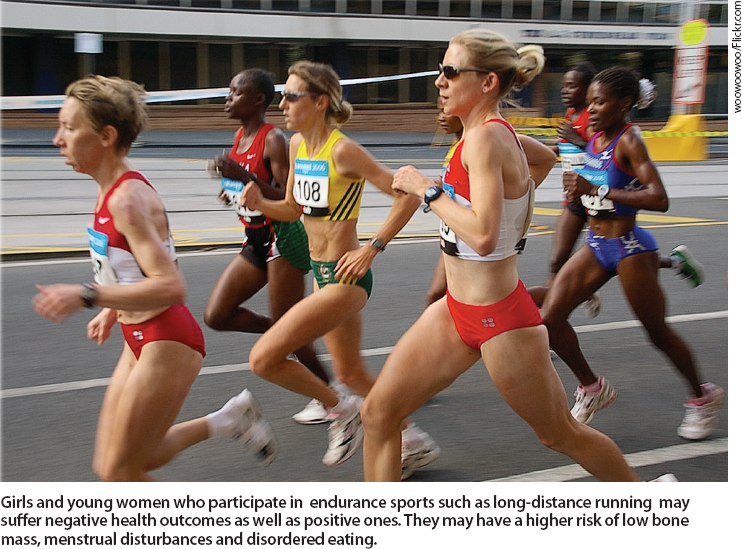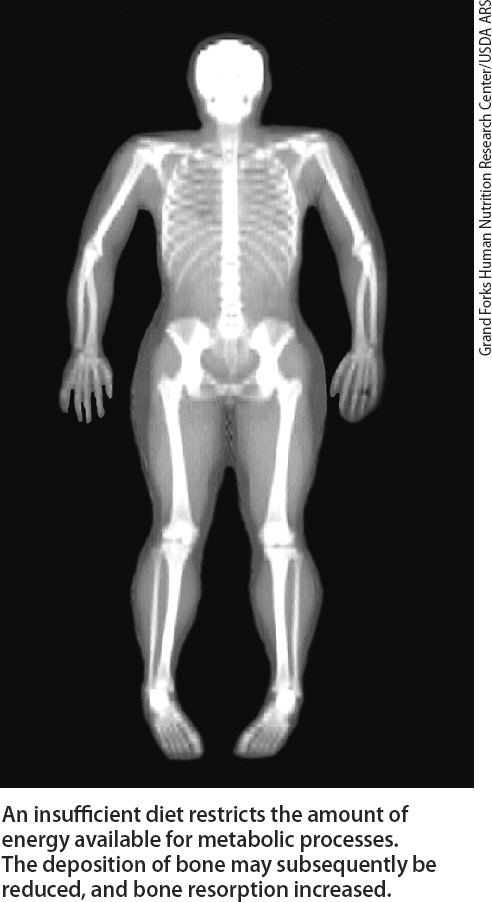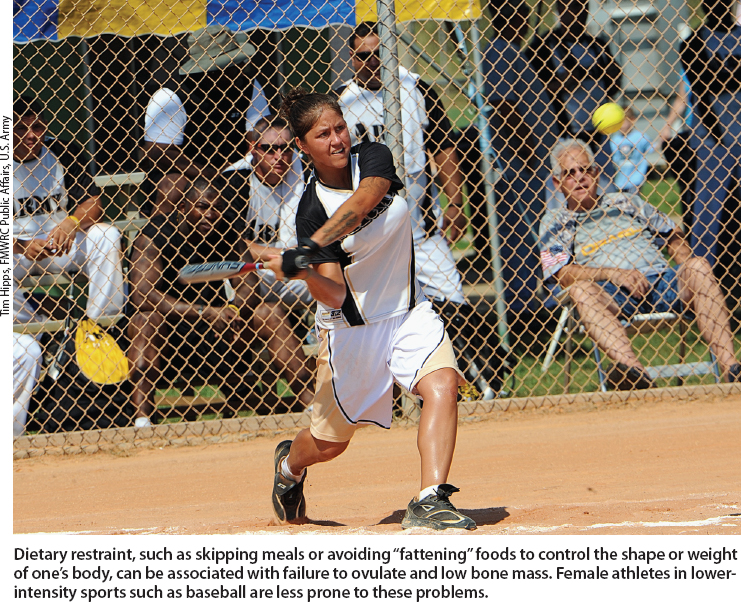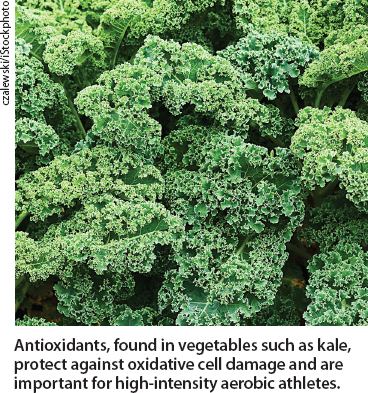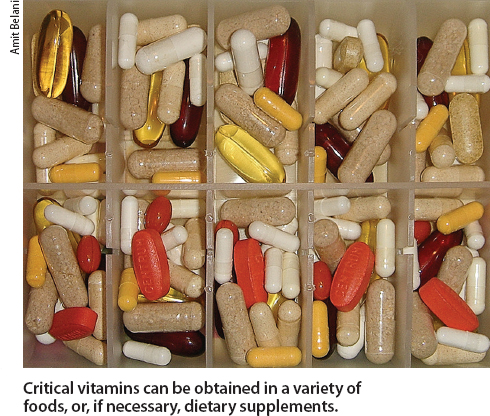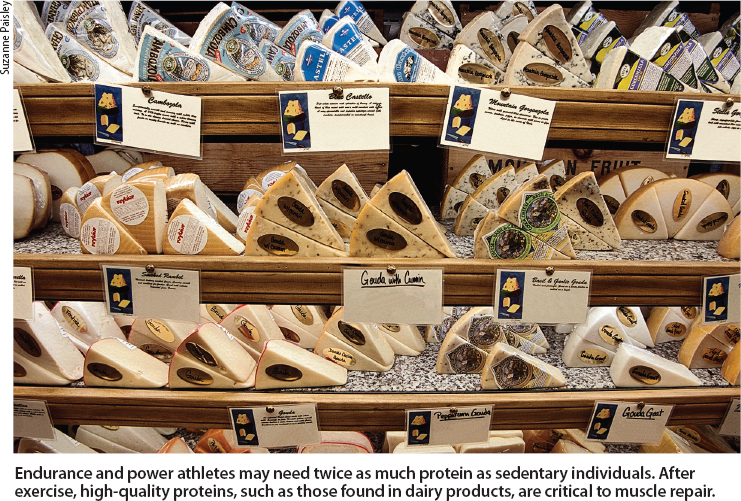All Issues
Proper nutrition can prevent negative health outcomes in young female athletes
Publication Information
California Agriculture 65(3):124-129. https://doi.org/10.3733/ca.v065n03p124
Published July 01, 2011
PDF | Citation | Permissions
Abstract
Since the onset of Title IX, opportunities have dramatically increased for female athletes, largely to their benefit. However, some negative health outcomes such as disordered eating, chronic menstrual disturbances and low bone mass have been associated with high-level competition among some female athletes, particularly in sports such as gymnastics and cross-country running, where a slender physique or lean body build is important. Adolescent female athletes, in a rapid growth and development phase, may be at greatest risk. We sought to identify athletes at risk, understand the origin of possible negative outcomes and recommend behavioral modifications that promote participation in competitive sports while supporting lifetime health. This review discusses the development and impact of disordered eating and menstrual dysfunction on bone mass in young, competitive, female athletes and provides nutrition recommendations for their energy, carbohydrate, protein, vitamin and mineral intake.
Full text
The arena of competitive sports for girls and young women was transformed by Title IX of the Education Amendments of 1972, which states, “No person in the United States shall, on the basis of sex, be excluded from participation in, be denied the benefits of, or be subjected to discrimination under any education program or activity receiving Federal financial assistance.”
In 1971, male competitors outnumbered females by more than five-to-one in college sports and more than twelve-to-one in high school sports (NCWGE 2008). Due to regulations set forth by Title IX, the number of female competitors in the National Collegiate Athletic Association (NCAA) increased more than 4.5-fold (from fewer than 30,000 to nearly 167,000) between 1971 and the 2004–2005 academic year (NCWGE 2008). Female high school athletic participation in the United States increased to a greater extent, from 300,000 in 1972 to over 2,950,000 in 2006 (NCWGE 2008). In 2009, there were nearly 300,000 female competitors in the California Interscholastic Federation alone (CIF 2009).
Girls and young women who participate in endurance sports such as long-distance running may suffer negative health outcomes as well as positive ones. They may have a higher risk of low bone mass, menstrual disturbances and disordered eating.
Athletic involvement by girls and young women has resulted in many positive health, cognitive, psychological and behavioral benefits. Research shows that regular exercise increases overall strength and aerobic fitness, improves cardiovascular health and lowers the risk of chronic degenerative diseases such as atherosclerosis and diabetes (Haskell et al. 2007; Hasselstrom et al. 2002; Kemper et al. 1999). For girls, sports participation enhances self-esteem and self-efficacy and reduces feelings of depression (Colton and Gore 1991). Various reports document higher academic performance, cognitive function and degree completion rates among girls and young women who engage in competitive sports (NCAA 2005). Furthermore, the use of tobacco and drugs, as well as sexual promiscuity, is lower among female athletes (Kulig et al. 2003).
Despite the many benefits, involvement in some sports — particularly those where a slender or lean body type (having less body fat) is important — has been associated with a higher risk of developing certain negative health outcomes. Girls and women participating in gymnastics and endurance sports such as crosscountry running have demonstrated low bone mass, particularly at the lumbar spine; menstrual disturbances, including fewer cycles or no cycle (amenorrhea); and a high prevalence of disordered eating (Beals and Hill 2006; Nichols et al. 2007; Torstveit and Sundgot-Borgen 2005a).
Female athlete health issues
Beals and Hill (2006) reported the eating attitudes and behaviors, menstrual function and bone mass of 112 female U.S. collegiate athletes. The authors observed that compared to other athletes, those with slender/lean body types had higher frequencies of moderate to extreme body dissatisfaction and binge eating, and a trend (P = 0.08) toward a higher frequency of self-described eating disorders. Slender or lean female athletes also exhibited a higher prevalence of menstrual irregularity (cycles less than 28 days, nine or fewer cycles per year or no cycle at all) and lower bone mass.
Low bone mass.
Low bone mass in young women can lead to the early onset of osteoporosis and increased risked for bone fractures. Mudd et al. (2007) compared data from 99 female collegiate athletes participating in 12 different sports and found that endurance runners had lower bone density throughout the body and particularly at the lumbar spine, compared to gymnasts and softball players, while swimmers exhibited significantly lower bone density in their legs compared to athletes in all other sports. Additionally, approximately 40% of collegiate or postcollegiate (Cobb et al. 2003) and adolescent endurance runners (Barrack et al. 2008) had low bone mass for their ages.
Menstrual irregularity.
Adequate reproductive hormones, especially estrogen, are needed for bone mineralization during adolescence and for continued bone maintenance thereafter. Up to 66% of female competitive endurance runners exhibit menstrual irregularities, and 40% have low bone mass (Barrack et al. 2008; Cobb et al. 2003; Gibson et al. 2004; Warren and Chua 2008). These rates are about three to five times higher than reported estimates of these same conditions in healthy young women and girls who do not run competitively (van Hooff et al. 1998).
Gibson et al. (2004) observed a 66% prevalence of menstrual irregularity among 50 elite female endurance runners. In a sample of 423 California high school athletes, Nichols et al. (2007) found that girls participating in sports that benefit from a lean or slender body type had a higher prevalence of menstrual irregularity (26.7% and 16.6%, respectively; P > 0.005) compared to athletes in other sports but no increased evidence of disordered eating.
Eating disorders.
Eating disorders have been shown to disrupt the menstrual cycle, resulting in low or no estrogen production. Adequate levels of estrogen are needed to increase bone mineralization and, in turn, bone density. In a sample of 300 female collegiate cross-country runners, Thompson (2007) reported that 19.4% either currently or previously had an eating disorder, while Hulley and Hill (2001) found that 16% of their sample of elite women distance runners had a current eating disorder. These estimates are considerably higher than the 0.5% to 2% occurrence of anorexia or bulimia nervosa in the population of young, healthy, adult female noncompetitive runners (Academy of Eating Disorders 2011).
Furthermore, among a sample of collegiate athletes, young women involved in aesthetic sports such as cheerleading, diving and gymnastics (lean or slender body-build sport types) had the lowest body weight and highest scores on the Eating Attitudes Test, which is indicative of abnormal eating attitudes and behaviors such as dietary restraint, in which the individual restricts food intake to control body weight (Beals and Manore 2002).
Female Athlete Triad syndrome.
These interrelated conditions (eating disorders, amenorrhea and osteoporosis) were first officially recognized and defined as the “Female Athlete Triad” by the American College of Sports Medicine Task Force on Women's Issues in 1993 (Yeager et al. 1993).
Subsequent epidemiologic studies found that among female athletes, the prevalence of all three aspects of this triad was low (about 1% to 3%) (Beals and Hill 2006; Cobb et al. 2003; Nichols et al. 2006). Several studies identified a portion of girls with menstrual disturbances but no eating disorders, and a portion of girls with low bone mass but no clinical menstrual disturbances (Hilton and Loucks 2000; Torstveit and Sundgot-Borgen 2005b). This prompted more research to better understand the causes of exercise-related low bone mass and menstrual disturbances in female athletes.
Energy deficit vs. exercise stress
An important question is whether these exercise-related health problems occur from an energy deficit, in which calories consumed do not meet calories needed for the increased level of physical activity, or from excess stress that alters the hormones regulating menstrual function and bone metabolism. Several well-controlled animal and human experimental studies have confirmed that as long as energy is available for physiological needs other than exercise, it promotes normal hormone function. This suggests that intense exercise does not in itself exert an additional stress that disrupts menstruation and bone metabolism.
Williams et al. (2001) trained a group of female monkeys to do 2 hours of endurance exercise (running) per day. The resulting energy deficit caused the complete cessation of their menstrual cycles. But once the monkeys were fed adequate calories to adjust for the increased energy expended on their endurance exercise regime, normal menstrual function gradually resumed over a period of 12 to 57 days. These findings demonstrate the critical role of energy in maintaining normal hormonal levels and menstrual function during exercise.
An insufficient diet restricts the amount of energy available for metabolic processes. The deposition of bone may subsequently be reduced, and bone resorption increased.
Ihle and Loucks (2004) evaluated the roles of energy deficiency and exercise stress on hormone concentrations that regulate bone metabolism by examining markers of bone turnover in 29 healthy, moderately active young women. First, the women spent 2 months on a balanced diet and exercise regimen that required about 25% of their energy intake. Then they were divided into three regimens where they continued to exercise at the same level but consumed a diet that was (1) adequate (met needs), (2) insufficient (met about 75% of needs) or (3) deficient (met about 55% of needs).
Dietary restraint, such as skipping meals or avoiding “fattening” foods to control the shape or weight of one's body, can be associated with failure to ovulate and low bone mass. Female athletes in lower-intensity sports such as baseball are less prone to these problems.
After just 5 days on an energy-restricted diet, women had significant changes in the hormones that regulate bone metabolism and turnover (such as thyroid hormone, insulin-like growth factor-1 and estradiol). Women on the insufficient diet had significantly lower thyroid hormone, insulin-like growth factor-1 and markers of bone deposition. Women on the deficient diet had even lower levels of these hormones and bone biomarkers, as well as significantly lower estradiol and increased bone resorption (the release of minerals such as calcium, magnesium and other nutrients).
Because the exercise stress remained constant, these findings indicate that energy deficits directly lowered metabolic rate, reduced bone deposition and increased bone resorption in a dosedependent manner. Together, these studies and others (Loucks and Thuma 2003) provide strong evidence of the direct role of low energy availability, not exercise stress, on the hormone disruptions contributing to menstrual disturbances and bone loss in female competitive athletes.
Low energy availability
Energy availability is the amount of energy that is not expended on exercise and therefore is available for performing the basal metabolic processes involved in organ function and the nonexercise activities of daily living. This relationship is represented in the following equation:
Energy Availability = (Energy Intake – Exercise Energy Expenditure) / Fat Free MassThis value is standardized for lean or fat free mass (the portion of body weight that is not fat) because lean muscle tissue accounts for more than 80% of an individual's resting metabolic rate (Stipanuk 2000).
When evaluating the relationship between energy availability and the hormones that regulate menstrual function, investigators found that hormone disturbances occurred below an energy availability level of 30 kilocalories per kilogram of lean tissue or fat free mass (kcal/kg FFM), regardless of whether this low energy availability occurred as a result of decreased energy intake or increased exercise energy expenditure (Loucks 2006; Loucks and Heath 1994). Low energy availability occurs when 66% or less of basal metabolic energy needs are met, which for young adults has been defined as below 30 kcal/kg FFM per day. The cutoff may be higher for adolescents, since they are in a period of growth and development; however, this has not been evaluated in young athletes. It is recommended that future studies employ similar research methods among healthy, regularly menstruating, noncompetitive adolescent athletes to identify the energy availability level below which hormone disturbances occur.
Disordered eating behaviors
Research has indicated that anorexia nervosa, a condition that entails extreme dietary restriction and compulsive exercise, as well as several other subclinical disordered eating behaviors, is highly related to low energy availability and the development of low bone mass. These subclinical disordered eating behaviors include dietary restriction, purging and overexercise without concurrent compensatory eating.
Anorexia nervosa.
Patients with anorexia nervosa chronically exist in a state of severely low energy availability and exhibit marked menstrual disturbances. As a result, bone mass is classically low, with many exhibiting lumbar spine bone densities that are about two standard deviations below the average for their age groups. While the consequences epitomize those of Female Athletic Triad syndrome, the prevalence of this disorder among female athletes is so low that it likely represents a small percentage of those at risk.
Subclinical behaviors.
More common are subclinical disordered eating behaviors such as dietary restraint, aimed at reducing overall energy (or fat) intake in an attempt to control one's body weight or shape. Behaviors practiced by restrained eaters include restricting “fattening” foods, avoiding eating for many hours, skipping meals and adopting rules or limitations regarding daily caloric intake.
Studies have identified an elevated prevalence of failure to ovulate (anovulation) and other subclinical menstrual disturbances (which disturb the menstrual cycle without necessarily causing amenorrhea) among several groups of adult women exhibiting excessive dietary restraint, including sedentary young adults, vegetarians and recreational runners (Barr et al. 1994). Additionally, both adult sedentary women and adolescent female endurance runners with restrained eating behaviors exhibited a greater degree of low bone mass (Barr et al. 1994; McLean et al. 2001). Reduced energy intake contributes to low energy availability, which likely accounts for the relationship between dietary restraint, menstrual dysfunction and low bone mass.
Menstrual disturbances, low bone mass
Menstrual disturbances have long been established as risk factors of low bone mass. While it was previously hypothesized that psychological or physiological stressors caused at least some cases of menstrual dysfunction, accumulating evidence indicates that most if not all menstrual disturbances in female athletes are preceded by an energy deficit due to dietary restriction or excessive exercise without adequate nutritional replenishment (Ihle and Loucks 2004).
Converging evidence from previous research studies has documented the direct effect of energy deficits on hormonal secretions from the pituitary gland, which controls many endocrine functions, including growth hormone production and the regulation of ovulation, as well as estradiol synthesis, all of which are needed for optimal bone mineralization and the attainment of peak bone density (Loucks 2006). Menstrual disturbances do not appear to cause low bone mass; rather, they are a sign of underlying hormone dysregulation, which may also negatively affect bone metabolism.
In addition, reduced bone mass can be associated with energy deficits that lower hormonal secretions, resulting in anovulation and other subclinical menstrual disturbances that often go unnoticed (McLean et al. 2001). Therefore, clinical menstrual function may not be an adequate signal of underlying hormone disruptions and associated bone-related risks. Because individuals with seemingly normal menstrual function may also be at risk of disrupted bone metabolism and consequently low bone mass, it is important to identify a proxy measure of low energy availability.
Antioxidants, found in vegetables such as kale, protect against oxidative cell damage and are important for high-intensity aerobic athletes.
Macronutrients for female athletes
Proper nutrition influences sport performance and overall health by, for example, reducing injury risk while increasing energy levels, recovery time and immune function. Given the high activity levels of athletes, their requirements for some nutrients are higher than those of the general population. It is important for female athletes to be aware of their unique requirements and maintain diets that satisfy their specific needs.
Just consuming enough energy (calories) is not enough. For optimal health and peak performance, it is critical to consume the three primary macronutrients for energy metabolism (carbohydrates, protein and fat) as well as a multitude of micronutrients (vitamins and minerals).
Energy.
Consuming adequate energy is necessary to support high-intensity or endurance exercise. The 2005 Institute of Medicine Dietary Reference Intake report provides energy intake recommendations for all ages, but these should be carefully defined for each athlete based on age, development stage, activity level and proportion of lean tissue mass (IOM 2005)
Carbohydrates.
Carbohydrates are important components of an athlete's diet, particularly an endurance athlete's. Besides being a primary macronutrient for energy metabolism, carbohydrates are needed to efficiently maintain the muscle glycogen that athletes use as fuel for vigorous exercise. It is recommended that athletes consume a high-carbohydrate snack or beverage 30 to 60 minutes after strenuous, glycogen-depleting exercise. This enhances both glycogen repletion and recovery from strenuous exercise. Depending on the athlete's training volume, carbohydrate requirements range from 6 to 10 grams per kilogram of body weight per day (IOM 2005), generally 50% to 60% of total energy intake.
Protein.
According to the most current research, the protein needs of athletes not participating in power (such as wrestling and weight lifting) or endurance (such as cross-country running) sports are similar to those of the general population. Therefore, most athletes’ protein needs can be met by consuming the recommended level of 0.8 grams per kilogram of body weight per day (IOM 2005). In addition, protein should make up 15% to 35% of total calories consumed. However, endurance and power athletes may require higher protein levels, ranging from 1.2 to 1.7 grams per kilogram of body weight per day, or almost twice the amount for sedentary individuals. This ensures that they are getting enough nitrogen, which is required for protein synthesis and muscle repair. To aid in postexercise repair, synthesis and maintenance of skeletal muscle, athletes should consume high-quality proteins (those with high bioavailability that contain the essential amino acids) such as soy and animal proteins, including egg and milk products (such as casein and whey).
Fat.
Besides yielding a substantial amount of energy, dietary fat provides important fat-soluble vitamins (A, D, E and K) and essential fatty acids. Dietary fat should make up 20% to 35% of the total diet and should provide no less than 20% of total energy needs to benefit athletic performance (Rodriguez et al. 2009).
Endurance and power athletes may need twice as much protein as sedentary individuals. After exercise, high-quality proteins, such as those found in dairy products, are critical to muscle repair.
Vitamins and minerals
Due to their relatively high metabolic and nutrient needs, athletes should consume diets that provide at least the recommended daily allowance (RDA) for all micronutrients for each individual's respective age group (IOM 2005).
B vitamins.
B vitamins facilitate energy metabolism (thiamin, riboflavin, niacin, pyridoxine, pantothenic acid and biotin) and promote muscle repair (folate, vitamin B12). Some reports suggest that the B vitamin requirements of competitive athletes are slightly elevated, and if so these higher needs likely are easily met with increased energy intakes. However, several B vitamins are often low in the diets of female athletes, including riboflavin, pyridoxine, folate and vitamin B12 (IOM 2005; Rodriguez et al. 2009). This can impair performance because severe deficiencies in vitamin B12 or folate can lead to anemia, a condition causing severe fatigue. B vitamin anemia is different from iron-related anemia and can affect the size of red blood cells. Animal-derived foods such as red meats and milk are good sources of B vitamins.
Antioxidants.
Antioxidant vitamins (such as C, E and the vitamin A precursor beta-carotene) and minerals (such as selenium) protect cell membranes from oxidative damage. These compounds become highly important during periods of increased exercise, particularly endurance-type exercise, since oxygen consumption increases 10 to 15 times with prolonged moderate- to high-intensity aerobic activity (IOM 2005; Manore 2002). Some reports suggest that vitamin E requirements for endurance athletes may be higher than for the general population. Vitamin E supplementation reduces inflammation and muscle soreness, speeding recovery times. It also deters exercise-induced DNA damage. Populations at risk of low vitamin C, vitamin E, beta-carotene and selenium intake are those with diets low in fat, energy, vegetables and whole grains (IOM 2005; Manore 2002); these foods should be incorporated into the diets of all athletes.
Calcium and vitamin D.
Calcium serves many important functions and facilitates nerve conduction, muscle contraction, the maintenance of blood calcium levels and the mineralization of bone. Calcium promotes normal growth, development and the maintenance of strong bones. Vitamin D facilitates the absorption of calcium, is important for calcium utilization in the body and improves immune defenses. Female athletes with the highest risk of calcium deficiencies are those with low energy intakes or those who do not meet the dietary recommendation of 3 to 4 servings of dairy foods (such as milk, yogurt and cheese) per day (ACSM et al. 2000). Further, calcium absorption may be hindered due to low estrogen levels in girls and young women exhibiting disordered eating or amenorrhea (Cobb et al. 2003; Gibson et al. 2004; Rodriguez et al. 2009).
The calcium and vitamin D requirements for athletes exhibiting these conditions increase from the normal 1,300 milligrams calcium and 200 IU (international unit) vitamin D per day, to 1,500 milligrams calcium and 400 to 800 IU vitamin D per day (ACSM et al. 2000). While vitamin D can be synthesized when skin is exposed to the sun's ultraviolent rays, sunscreens inhibit this natural process, making adequate dietary intake essential.
Iron.
Iron is an important mineral for optimal athletic performance due to its role in energy production as well as its oxygen-carrying capacity (ACSM et al. 2000). Iron is a component of the hemoglobin in red blood cells, which transport oxygen to working muscles. Inadequate iron is one of the most common nutritional deficiencies among female athletes and leads to impaired muscle function and reduced performance during workouts and competition (Rodriguez et al. 2009). The iron needs of endurance athletes may be up to 70% higher than those of the general population (ACSM et al. 2000). Endurance athletes who consume primarily a vegetarian diet take in non-heme iron, a form that is absorbed much less efficiently than heme iron, which is found in red meat (IOM 2005). Female athletes at risk of low iron levels are endurance runners, vegetarians, adolescents and athletes who frequently donate blood (IOM 2005; Rodriguez et al. 2009). The recommendation for iron is 18 milligrams per day and can be obtained most easily from red meats.
Zinc and magnesium.
Zinc is important for normal growth, immune function, muscle repair and energy production. Zinc also reportedly influences basal metabolic processes, protein utilization and thyroid hormone function. Low zinc levels have been associated with reduced muscle strength, aerobic function and endurance (IOM 2005; Rodriguez et al. 2009). Female athletes with low animal protein and high fiber intakes are at increased risk of developing zinc deficiency.
Adequate magnesium levels in conjunction with zinc aid performance because of their joint roles in facilitating cellular metabolism, and cardiovascular, immune and hormone function. Magnesium deficiencies increase the oxygen required for endurance exercise, hindering performance. Athletes with diets low in energy have been documented to consume low magnesium levels. The daily recommended amounts of zinc and magnesium for adolescents are 12 and 300 milligrams per day, respectively. Readily available sources of these nutrients are animal red meats and milk.
Unique nutritional needs
Adolescent athletes represent a distinct subpopulation, since their diets must satisfy nutrient requirements for growth and development as well as the demands of their sports. The optimal diet for a young, developing athlete should maximize sport performance, while reducing injury risk and facilitating overall health, growth and maturation. Due to the metabolic and physiologic demands of their sports, the nutrient needs of young athletes can be much higher than their nonathlete peers and higher than the needs of young adult athletes who have reached maturity. It is important to make competitive adolescent athletes aware of their specific needs as well as to identify those athletes at risk of developing deficiencies.
Counseling by a registered dietitian may be necessary to design diets that meets the unique needs of adolescent female athletes. While prior research has provided valuable information about athlete groups with a potential increased risk of developing menstrual disturbances and low bone mass, the majority of studies assessed collegiate and adult athletes and looked at groups at only one point in time. Therefore, it is recommended that future research evaluate adolescents over time to identify the nutritional and exercise behaviors that optimize bone mineral gains and reduce fracture risk. Further, it is necessary to educate athletes, parents, coaches and athletic trainers about behaviors that promote lifetime bone health.



